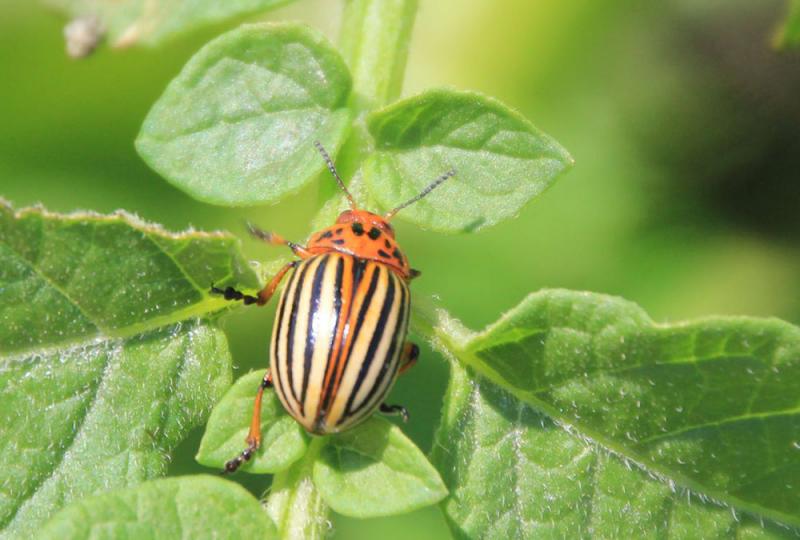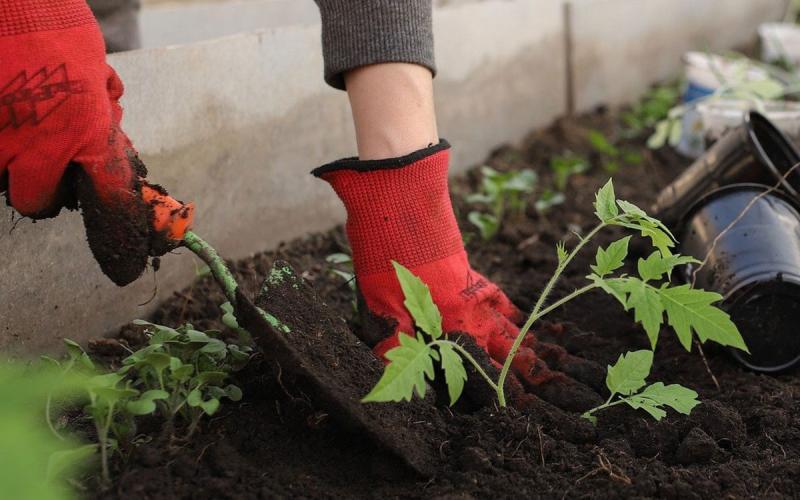Pest Profile

Colorado potato beetles have become all too common in many home gardens and also in community gardens where potatoes are commonly grown. These small voracious eaters have been plaguing potato growers since the late 1800’s. If left untreated, they can soon defoliate potato plants, drastically cutting yields of the delicious tubers that so many of us love to eat. In addition, they will also feed on some other vegetables like eggplant and even tomatoes if they get hungry enough.

Lifecycle and Behavior
Potato beetles are fairly easy to identify. The adult beetles are oval in shape and about ½” long. They are yellow-orange in color with 10 narrow stripes running down the length of their body.
Adult Colorado potato beetles lay eggs on the underside of the leaves, usually in clusters of a dozen or so at a time. An adult female beetle might lay up to 350 eggs in its lifetime. The eggs hatch in about a week or so, depending on the temperature. The larvae emerge and start feeding almost immediately.
The larvae start out a brick red color with a black head but gradually turn more of a pink color as they age. They also have two lines of black spots. The youngest larvae are quite small and may be difficult to see but you will likely notice their damage and the older larvae which take one to two weeks to mature, molting three times before their most destructive final larval stage. Then the larvae drop to the ground and burrow down to pupate for another 8 to 15 days before emerging as adults, ready to eat and make more Colorado potato beetles. In the fall, the last generation overwinters as adults. In the spring, when the soil warms up, the beetles emerge and look for potatoes to start feeding on and lay their eggs.
Management Tips
Colorado potato beetles are one of the most troublesome garden pests because they feed on one of our favorite vegetables and they are so persistent and difficult to control. Try to use a variety of methods to control them and you will probably still get to harvest at least some potatoes unless the plants were badly defoliated after blooming.
- Hand picking of the adults and larvae, and also squishing the yellow-orange egg clusters, have also been a traditional method of reducing beetle damage but it can be an overwhelming task. I have heard of some gardeners offering to pay their kids a penny a beetle to pick them off the plants.
- Crop rotation can also help but it is usually not very effective in a small garden or a community garden where there are always plenty of potato plants around to keep the life cycle of the insect going from year to year.
- Some gardeners also use insect eating birds, like chickens, ducks or geese to help keep the beetles in check but sometime the birds can do more damage than good.
- Row covers may also help in keeping the beetles away from the plants but remember that the adults overwinter in the soil so you may be “fencing” them in with your young potato plants, unless you are planting in a new spot in your garden that has not been planted in potatoes for a few years.
Insecticides
Home gardeners and commercial growers have been fighting Colorado potato beetles in a variety of ways from using lead-arsenate 30 to 40 years ago, to using more modern insecticides like carbaryl (Sevin) in more recent times, to even using flamers in commercial production to kill the first emerging beetles in recent years. The problem is that these beetles have grown to be resistant to many of the insecticides that were long used to control them. Sevin was the standard garden dust that so many of us relied on to control the beetles, but it is now almost useless to control them. Part of the problem is that gardeners kept using the same insecticide over and over again which helps insects to become resistant to a particular insecticide.
There are some insecticides that can provide some control for the home gardener. There is an organic product called Bacillus thuringiensis var. san diego, often just called B.t. But you have to look for the formulation that is effective against beetles, not the ones that are available for controlling caterpillars or other insects. This is a stomach poison for the beetles and controls them after they eat foliage that has been treated with the B.t. It has to be applied repeatedly to maintain control.
Some other chemical options include insecticides that contain the active ingredient of Azadirachtin. Some trade names to look for include: Azatin XL Plus, BioNeem, Margosan-O, and Neemix. This chemical interferes with the molting process of the larvae. Another product to look for will contain Rotenone, an insecticide that has been around for a long time and it still appears to be effective against Colorado potato beetles, at least to the youngest larval stages. Once the larvae get to the 4th instar (after molting three times) they become much more difficult to control and the larvae cause much more damage.


